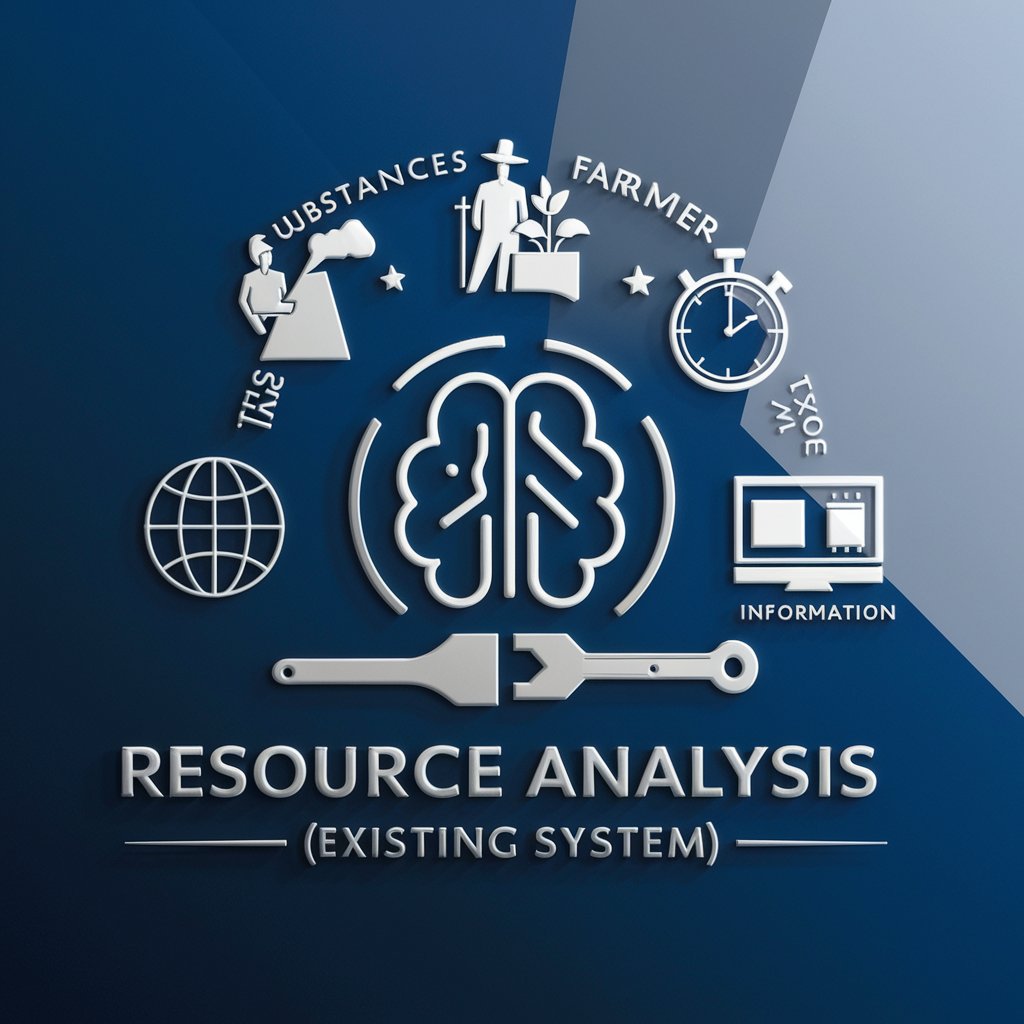
Resource Analysis (Existing System) - In-depth System Analysis

Welcome! Let's optimize your system resources.
Unleash Efficiency with AI-Powered Analysis
Analyze the resources required for...
Identify the key components of...
Evaluate the efficiency of...
Examine the functional aspects of...
Get Embed Code
Overview of Resource Analysis (Existing System)
Resource Analysis (Existing System) is a specialized analytical framework designed to evaluate and optimize the utilization of resources within an existing system. This methodology systematically categorizes resources into substance resources, field resources, time resources, space resources, information resources, and functional resources. It emphasizes identifying, analyzing, and understanding the parameters of each resource category to enhance efficiency, productivity, and effectiveness. For example, in the brewing process of 3-in-1 coffee, this analysis would dissect elements such as the types of coffee and packaging materials used (substance resources), the energy sources for boiling water (field resources), the timing for boiling and brewing (time resources), and the technologies employed for packaging and brewing (functional resources). Powered by ChatGPT-4o。

Core Functions of Resource Analysis (Existing System)
Resource Categorization
Example
In the manufacturing of electronic devices, resources are categorized into components like silicon chips (substance), factory layout (space), assembly line speed (time), and soldering techniques (functional).
Scenario
This function aids in pinpointing areas for improvement, such as optimizing the assembly line for better productivity.
Optimization of Resource Utilization
Example
In urban planning, optimizing the use of space resources might involve redesigning public spaces to serve multiple purposes, thereby enhancing community engagement and satisfaction.
Scenario
Identifying underutilized spaces and proposing multi-functional areas can significantly improve urban space efficiency.
Identification of System Constraints
Example
In software development, this might involve analyzing the time resource constraints related to development cycles and identifying bottlenecks in the coding and testing phases.
Scenario
By pinpointing these constraints, teams can allocate resources more effectively, improving project timelines and outcomes.
Target User Groups for Resource Analysis (Existing System)
Manufacturers and Product Developers
These users can leverage resource analysis to streamline production processes, reduce waste, and innovate in product design by understanding material and functional resources deeply.
Urban Planners and Architects
For these professionals, space and time resource analysis is crucial for designing sustainable and efficient urban environments, optimizing the use of land, and improving public spaces.
Project Managers and Business Analysts
They utilize this analysis to enhance project planning, resource allocation, and efficiency, particularly in terms of time and information resources, ensuring projects are completed on time and within budget.

Guidelines for Using Resource Analysis (Existing System)
Start Your Journey
Visit yeschat.ai for a complimentary trial without the necessity of logging in or having a ChatGPT Plus subscription.
Identify Your Needs
Clearly define the problem or system you wish to analyze using Resource Analysis to ensure focused and relevant outcomes.
Input System Details
Provide detailed information about your existing system, including all relevant resources such as materials, energy, information, and technology.
Analyze and Interpret
Utilize the Resource Analysis tool to categorize and assess the parameters of each resource within your system.
Apply Insights
Use the insights gained from the analysis to optimize resources, enhance system efficiency, or address specific challenges.
Try other advanced and practical GPTs
Logo Craft
Craft Your Brand's Identity

Cheese Expert V2.4.5 (BETA)
Unlock Cheese Secrets with AI

Cheese Enthusiast
Explore Cheese with AI

Cheese Connoisseur
Unlock the world of cheese with AI-powered guidance.

Cheese Connoisseur
Elevate Your Cheese Game with AI

Cheese Connoisseur
Unleash AI-Powered Cheese Mastery

Ai Ai Chef
Transform ingredients into meals with AI

Coach Victory GPT
Elevate Your Game with AI Coaching

Victory the Insult Comic Wolf
Roast to Boast: AI-Powered Humor

Sweet Victory
Overcome sugar cravings with AI-powered support.

Valorant Victory Guide
Elevate Your Game with AI-Powered Valorant Insights

Victory Royale Vision
Transform photos into Fortnite adventures.

Frequently Asked Questions about Resource Analysis (Existing System)
What is Resource Analysis (Existing System)?
Resource Analysis (Existing System) is a methodological tool designed to categorize and assess various resources within a system, such as materials, information, and technology, to improve efficiency and address problems.
Who can benefit from using this tool?
Engineers, product designers, business analysts, and educators can benefit from applying this tool to streamline operations, enhance product designs, or facilitate learning.
Can this tool analyze any type of system?
Yes, it is versatile and can be applied to a wide range of systems, including manufacturing processes, educational programs, and technological devices.
How does this tool help in problem-solving?
By identifying and evaluating the resources involved in a system, it helps uncover inefficiencies, redundancies, and potential improvements, leading to more informed decision-making.
Is there any prerequisite knowledge needed to use this tool?
Basic understanding of the system to be analyzed is helpful, but the tool is designed to guide users through the analysis process, making it accessible to a broad audience.